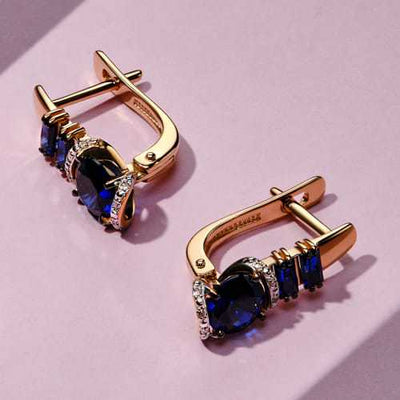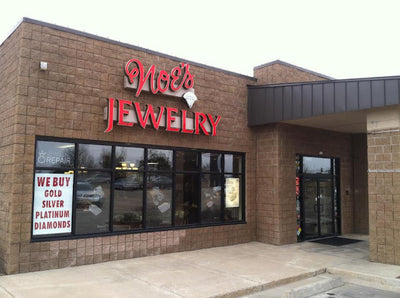Gemstones have been treasured by societies for centuries. Given as symbols of love, friendship, success, or just because, gemstones have become common in many cultures around the world. As technology has improved, access to hard-to-reach gemstones has added to the variety and options available to consumers. Let’s learn more about how gemstones are formed and how they are mined.
How Are Gemstones Formed?
Gemstones are formed from different types of rock. These rocks are made of minerals that bond together to form a crystalline structure. This crystalline structure, with the right mix of ingredients and atmospheric conditions, will become a gemstone. Time, temperature, space, pressure, and natural ingredients determine what kind of gemstone is formed, as well as the quality of that gemstone.
- Igneous: This type of rock holds some of the world’s most valuable gemstones in the quartz family. Diamonds are formed deep under the surface of the Earth, under extreme heat and pressure, in igneous rock. Gemstones such as amethyst, ametrine, citrine, garnets, moonstones, topaz, and zircon also form here.
- Metamorphic: This type of rock is full of gemstones that are beautiful and colorful. Gemstones such as jade, lapis lazuli, turquoise, zircon, and sapphire are formed in this layer of rock. This rock layer binds minerals together with intense pressure and heat generated by the movement of tectonic plates.
- Sedimentary: This type of rock is the closest to your feet, though still miles below the surface of the Earth. This layer forms gemstones such as jasper, malachite, zircon, and opal. These gemstones are formed when water, rich with minerals, travels below the surface of the Earth, trapping the minerals and allowing pressure and heat to form gemstones.
Where Are Gemstones Found?
Gemstones are created deep in the Earth’s core and pushed closer to the surface through natural processes. Earthquakes, volcanoes, and plate shifts are a few examples of these natural processes. This process still leaves gemstones miles underground, though they are now close enough to the surface to be mined. Diamonds and peridot are the deepest gemstones to mine, resting about 125 miles below ground. Most other gemstones can be found three to 25 miles below the Earth’s surface.
How Do We Mine Gemstones?
There are multiple ways to mine gemstones. The conditions of the Earth, as well as the type of gemstone being mined for, determine the technique used for mining. Some mining techniques require heavy equipment and lots of manpower. They can also be very expensive. Other types of mining precious stones have less of an impact on the environment and are less costly. Here’s how gem mines work.1. Underground Mining
Underground mining is used to excavate minerals and gemstones deep under the ground. A series of tunnels and shafts are created to reach the gemstones, and then they are brought back up to the Earth’s surface. There are several different techniques that can be used for underground mining, including:
- Tunneling is a technique used when there is a gem-bearing rock or a seam near the Earth’s surface. Once the seam or rock is located, a tunnel is created and gemstones are removed by blasting the area or using a pickaxe to remove the deposit. Tunneling is often used to retrieve emeralds.
- Chambering is used when there is a vein, or a deposit or minerals, showing in stone or the Earth. A vertical shaft is dug into the Earth near the vein. Tunnels are then created to reach the vein at various places. Once the gemstones are reached, blasts loosen the gemstones from the Earth and this material is transported to the surface.
- Block caving is often used for mining diamonds. This technique involves a main shaft that allows miners to reach the rock or gemstones they are wanting to extract. A series of parallel tunnels are then dug underneath the rock, allowing its weight to collapse the rock. The rock can then fall into the space dug below it, breaking it up and allowing it to be transported to the surface.
2. Open Cast Mining
Open Cast Mining is what most people think of when they think of diamond or gemstone mining. Open cast mines are giant pits and are often deep and wide. The sides of the tunnel are blasted at an angle less than vertical to prevent rock from falling and to stabilize the size of the pit. This method of mining is used when there are gems near the surface of the Earth and the soil covering them is relatively thin.
Open cast mining is hard on the environment and can leave large pits on the surface of the planet. These pits often undergo land rehabilitation once the mining is complete. These mines have been repurposed into recreational parks, residential communities, or wetland areas.
3. River Digging
River Digging can be a great way to collect colorful gemstones, depending on your location. Opals, amethysts, garnets, rubies, topaz, and other colorful stones have been found in lakes and riverbeds all over the world. There are two different techniques that are used by miners for digging in lakes and rivers.
- Wet Digging is also known as panning. This is a technique that involves collecting sediment and small rocks from a river or lakebed. The material is washed and then shaken in the pan, allowing all of the heaviest material to settle in the bottom of the pan. Gemstones can then be collected from the pan, and the process is repeated.
- Dry Digging blocks off the flow of a river at both ends using dams. This allows the miner to access the dry area to collect and dig for gemstones.
4. Sea Mining
Sea Mining is done on beaches or deep in the sea. Deep-sea dredging involves the use of heavy machinery and hydraulics to extract deposits of gems from the sea floor. Gemstones are then moved to the surface of the water through a hydraulic suction system or a conveyer belt that runs from the bottom of the ocean to the surface of the water. This process is very expensive and mostly used for mining diamonds.
Some types of gemstones can be retrieved from the ocean with a fishing net. Pearls and amber can be collected from the ocean by divers or with a net. Sometimes gemstones wash ashore, allowing them to be picked up on the beach.
If you are in the market for precious gemstone jewelry, visit Noe’s Jewelry in Raymore, Missouri. Our team of expert jewelers can help you find just the right piece of jewelry. Stop on in or give us a call today at 816-322-7227.






